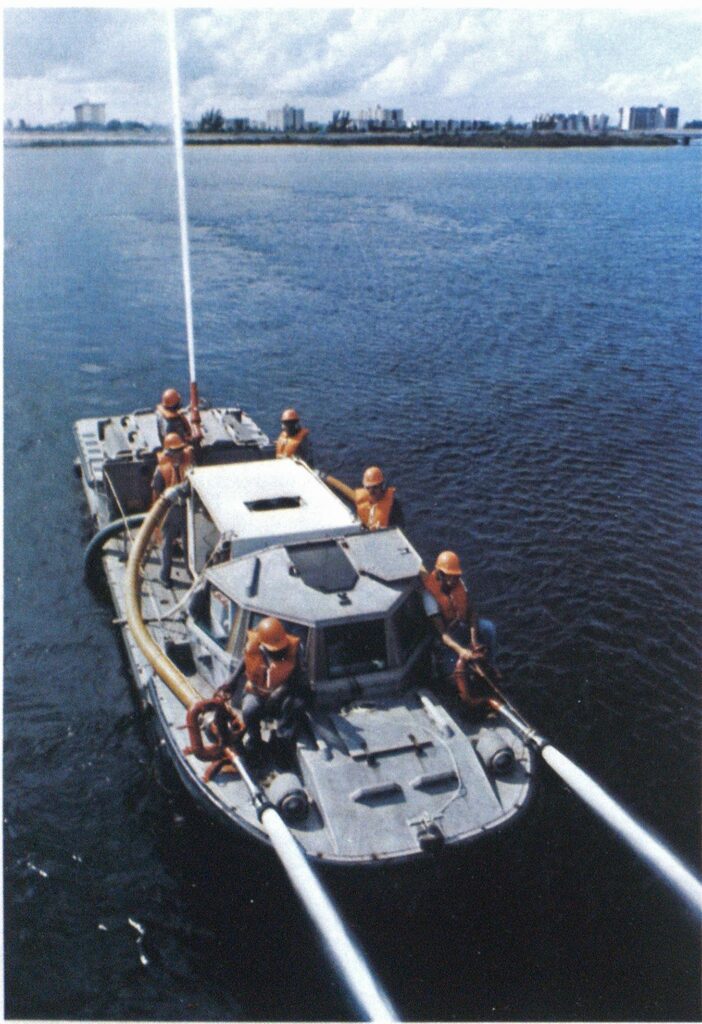
Space-Age Pump Installed on Amphib Gives Miami a 2500-GPM Fireboat
features
A new space-age fire pump, the result of a Marshall Space Flight Center, NASA Technology Transfer Program, has been mounted by the City of Miami Fire Department on an amphibious craft. The pump was supplied by Aviation Power Supply Inc. of Burbank, Calif., and tests conducted so far have proved the versatility of this combination of equipment.
The vehicle, a surplus Army amphibious craft is approximately 35 feet long with a 10-foot beam, can travel 30 mph on land and 10 mph on water. It can be launched or retrieved from bays, rivers, lakes, etc., on all types of terrain up to a 60-degree incline. This 300-hp, aluminum-bodied diesel craft was acquired from the Army through the Marshall Space Flight Center at Huntsville, Ala., under a 10-year agreement to increase the sophistication of the amphibious fireboat concept by utilizing the lightweight fire fighting module (LFFM). Funding was made available through the City of Miami Firefighting, Fire Prevention and Rescue Facilities Bond Program,
The new type pump being tested (Firefly I) is designed to be a lightweight package. It has the capability of delivering 2500 gpm at 150 psi and is totally self-contained. The total package weighs only 2500 pounds, including 1000 pounds of fuel. And the pump, 155 pounds, is powered by a 400-hp turbojet engine which weighs only 158 pounds.
Louis DeChime, chief of support services for the Miami Fire Department, has worked for over a year to acquire the amphibious craft. It was his opinion that the Firefly could be adapted to these craft, but many questions needed to be answered, such as :
- Stability when producing maximum gpm,
- Maneuverability, and
- The arrangement of suctions and discharge lines.
Versatility proved
The demonstration he conducted in Miami with the assistance of APS engineers proved the versatility of this concept. With two forward-mounted bow monitors with 1250-gpm fog nozzles, and a rear-mounted 4-inch deck pipe with a 3-inch solid stream tip, the amphibian performed with great stability and ease of maneuvering—even with all three appliances operating at capacity.
The final configuration will reduce the pump module dimensions to 48 inches high by 26 inches wide by 83 inches long. This will be accomplished by mounting the fuel tanks in the amphibian hull rather than underneath the pump module. All plumbing will be hard-anodized aluminum, installed above deck, and directly connected to the bow and stern monitors. Supply line manifolds will be provided and both bow monitors will be able to discharge 1500 gpm with remote-control from the amphibian’s cabin.
After a series of land maneuvers utilizing several different scenarios, the LARC was moved to a beach. There, with its wheels on the ground and the suctions in about 2 feet of water, two 5-inch hose lines were stretched to supply two 1250-gpm pumpers on shore. The pumpers in turn supplied two large master stream devices, one with a 1 3/4-inch tip and the other with a master stream fog nozzle.
The final scenario demonstrated a rapid blanketing of a parking lot with foam in less than 30 seconds, using an Angus Foam Cannon and 20 gallons of aqueous film-forming foam (AFFF).


—Miami Fire Department photos

Water rescue facility
The low freeboard and stancheons on the amphibious craft can be dropped to allow easy water rescue. The very flat, stable deck provides a good diving platform for rescuers to work from.
The great versatility and stability of this craft has led us to believe that it may be possible to mount a 30 or 40-foot water tower with a remote-control nozzle. This addition not only would allow elevated streams but also easy mounting of floodlights for nighttime operations.
The new unit generated interest in departments in the Miami area. It also proved of interest to representatives from the Homestead Air Force Base, United States Coast Guard 7th District, the Port of Miami, as well as several cruise ship companies operating out of the Port of Miami. Officials of the City of Miami have felt for many years that marine fire fighting capability was a necessity in this area not only because of the more than 22.5 linear miles of waterfront within our city limits but also because of the rapidly expanding pleasure cruise ship activity at the Port of Miami.
The Port of Miami handles as many as 254 United States and foreign ships monthly, with a total of 2669 cargo and passenger ships this year. It is also the busiest passenger seaport in the United States in both passengers and sailings and handles approximately 92,636 passengers monthly, with a total of 1,328,816 this year to date; and 1775 United States and foreign freighters accounted for 7,124,028 tons of cargo. Beginning December 1979, the world’s largest cruise ship, the S.S. Norway, will be operating out of the Port of Miami.
Because of the cost of a traditional fireboat, not only in initial capital outlays, but for berthing facilities, manning, etc., this approach was never considered. We have been seeking an alternative for several years, looking at small jet-powered craft, etc., which never quite met our expectations or our needs. The unique combination which we tested utilizing an amphibious craft would limit our initial investment to approximately $200,000 for equipment, engineering, and modification, and would allow storage in existing fire stations. Inasmuch as this equipment could be stored in a multi-company firehouse, it could be dispatched in a normal manner and could be manned by existing personnel from that station on those special occasions when this vehicle was needed.
The versatility of this apparatus will allow water operations and land operation with water supplied either from draft or city hydrants, and during hurricanes or flooding, the ability of the amphibious craft to maneuver would be difficult to match.
We think that the tests which were conducted in Miami will revolutionize the methods of providing fire protection along waterfronts in many parts of this country.


